Radio Wave Attenuation Measurement System Based on RSSI for Precision Agriculture: Application to Tomato Greenhouses
Abstract
1. Introduction
2. Radio Wave Attenuation Measurement System in a Greenhouse
2.1. Architecture
2.2. System Hardware
- Re-Mote nodes. Zolertia’s Re-Mote motes have radio transceiver modules capable of acting as a Tx transmitter and Rx receiver node. It was chosen because its board is an IoT platform with extensive Contiki OS software support, including 6LoWPAN, RPL and other widely used IoT protocols. It integrates Texas Instruments’ CC2538 System-on-Chip (SoC) chip for low-power, short-range communication in the 2.4 GHz band, with a current consumption of 24 mA when transmitting, 20 mA when receiving, and 1.3 uA in the sleep state [42,43,44]. On the other hand, the EIRP (equivalent radiated isotropic radiated power) of the Tx node was −29 dBm in the tests and 5 dBi gain antennas were used for both motes. The re-receive sensitivity at the Re-Mote nodes was −97 dBm.
- Lithium-ion battery. The lithium-ion battery was connected to the 3.7 V Tx transmitter to maintain the transmitter’s autonomy.
- Humidity and temperature sensor. In addition, the DHT22 sensor was connected to the transmitter module to transmit temperature and humidity data, which are traditionally used to monitor and supervise the environmental conditions of the crop in a greenhouse.
2.3. System Software
- Re-Mote nodes. The Contiki operating system, developed in 2002 by Adam Dunkels, was installed and configured as an open source runtime environment for low-power, memory-limited wireless sensor nodes [46]. It is lightweight, making it ideal for IoT. Its applications are developed with the C programming language. It has a built-in TCP/IP implementation for embedded devices, officially supporting various device platforms that make up wireless sensor networks, including the Re-Mote board [47,48,49]. Only Contiki’s power-saving module (power-mgmt.h) was used in the transmitter node, because during the test phase this station is the one that is far away from the receiver node and does not have an electrical outlet, instead being powered by its own battery. The receiving node was powered by the Raspberry Pi, which in turn was connected to a power socket at one end of the greenhouse. For radio communication, we employed the Rime stack (rime.h), which provides a set of basic communication primitives for best-effort single-hop network broadcasting (“unicast”) and reliable multi-hop “multi-hop unicast” [50].
- The program developed in C for the transmitter station sends frames of temperature and humidity data obtained from the DHT22 sensor periodically on a variable timer, while remaining suspended the rest of the time. This reduces power consumption, extending the transmitter’s autonomy. On the other hand, the receiving station, powered by the Raspberry Pi and the greenhouse socket, measures the RSSI and obtains the data frame sent by the transmitter node.
- Raspberry Pi. The Raspbian distribution based on Debian was installed and several scripts were developed in the Python language that established serial communication with the Zolertia devices and generated.csv files with the data they receive, storing them in the SD memory of the Raspberry Pi. It also has a clock module with a CR2032 battery so that the date and time are not decalibrated when it is turned off, recording it with each RSSI record.
3. Deployment and Commissioning in a Tomato Greenhouse
3.1. Deployment of the System
3.2. Conducting Experiments
3.3. Measurement Procedure
4. Radio Wave Attenuation Dataset in Tomato Greenhouse
5. Discussion
6. Conclusions and Future Work
Author Contributions
Funding
Data Availability Statement
Conflicts of Interest
References
- Rangwani, D.; Sadhukhan, D.; Ray, S.; Khan, M.K.; Dasgupta, M. An improved privacy preserving remote user authentication scheme for agricultural wireless sensor network. Trans. Emerg. Telecommun. Technol. 2021, 32, e4218. [Google Scholar] [CrossRef]
- Cama-Pinto, D.; Damas, M.; Holgado-Terriza, J.; Gómez-Mula, F.; Calderin-Curtidor, A.; Martínez-Lao, J.; Cama-Pinto, A. 5G Mobile Phone Network Introduction in Colombia. Electronics 2021, 10, 922. [Google Scholar] [CrossRef]
- Mentsiev, A.U.; Gatina, F.F. Data analysis and digitalisation in the agricultural industry. IOP Conf. Series Earth Environ. Sci. 2021, 677, 32101. [Google Scholar] [CrossRef]
- Azman, A.S.; Lee, M.Y.; Subramaniam, S.K.; Feroz, F.S. Novel Wireless Sensor Network Routing Protocol Performance Evaluation using Diverse Packet Size for Agriculture Application. Int. J. Integr. Eng. 2021, 13, 16–28. [Google Scholar] [CrossRef]
- Vanishree, K.; Nagaraja, G.S. Emerging Line of Research Approach in Precision Agriculture: An Insight Study. Int. J. Adv. Comput. Sci. Appl. 2021, 12. [Google Scholar] [CrossRef]
- Peng, Y.; Xiao, Y.; Fu, Z.; Dong, Y.; Zheng, Y.; Yan, H.; Li, X. Precision irrigation perspectives on the sustainable water-saving of field crop production in China: Water demand prediction and irrigation scheme optimization. J. Clean. Prod. 2019, 230, 365–377. [Google Scholar] [CrossRef]
- Caicedo-Ortiz, J.G.; De-La-Hoz-Franco, E.; Ortega, R.M.; Piñeres-Espitia, G.; Combita-Niño, H.; Estévez, F.; Cama-Pinto, A. Monitoring system for agronomic variables based in WSN technology on cassava crops. Comput. Electron. Agric. 2018, 145, 275–281. [Google Scholar] [CrossRef]
- Caicedo Ortiz, J.G.; Acosta Coll, M.A.; Cama-Pinto, A. WSN deployment model for measuring climate variables that cause strong precipitation. Prospectiva 2015, 13, 106–115. [Google Scholar] [CrossRef]
- Miao, Y.; Zhao, C.; Wu, H. Non-uniform clustering routing protocol of wheat farmland based on effective energy consumption. Int. J. Agric. Biol. Eng. 2021, 14, 142–150. [Google Scholar] [CrossRef]
- Razafimandimby, C.; Loscri, V.; Vegni, A.M.; Neri, A. Efficient Bayesian Communication Approach for Smart Agriculture Applications. In Proceedings of the 2017 IEEE 86th Vehicular Technology Conference (VTC-Fall), Toronto, ON, Canada, 24–27 September 2017; Institute of Electrical and Electronics Engineers (IEEE): New York, NY, USA, 2017; pp. 1–5. [Google Scholar]
- Salim, C.; Mitton, N. K-predictions based data reduction approach in WSN for smart agriculture. Computing 2020, 103, 509–532. [Google Scholar] [CrossRef]
- Wu, H.; Miao, Y.; Li, F.; Zhu, L. Empirical Modeling and Evaluation of Multi-Path Radio Channels on Wheat Farmland Based on Communication Quality. Trans. ASABE 2016, 59, 759–767. [Google Scholar] [CrossRef]
- Cama-Pinto, A.; Gil Montoya, F.; Gómez-López, J.; García-Cruz, A.; Manzano-Agugliaro, F. Wireless surveillance sytem for greenhouse crops. DYNA 2014, 81, 164. [Google Scholar] [CrossRef]
- Montoya, F.G.; Gomez, J.; Manzano-Agugliaro, F.; Cama, A.; García-Cruz, A.; De La Cruz, J.L. 6LoWSoft: A software suite for the design of outdoor environmental measurements. J. Food Agric. Environ. 2013, 11, 2584–2586. [Google Scholar]
- Hsiao, S.-J.; Sung, W.-T. A Study on Using a Wireless Sensor Network to Design a Plant Monitoring System. Intell. Autom. Soft Comput. 2021, 27, 359–377. [Google Scholar] [CrossRef]
- Xuanrong, P.; Tingdong, Y.; Yuesheng, W. Research and design of precision irrigation system based on artificial neural network. In Proceedings of the 2018 Chinese Control and Decision Conference (CCDC), Shenyang, China, 9–11 June 2018; Institute of Electrical and Electronics Engineers (IEEE): New York, NY, USA, 2018; pp. 3865–3870. [Google Scholar]
- Zapata-Sierra, A.J.; Cama-Pinto, A.; Montoya, F.G.; Alcayde, A.; Manzano-Agugliaro, F. Wind missing data arrangement using wavelet based techniques for getting maximum likelihood. Energy Convers. Manag. 2019, 185, 552–561. [Google Scholar] [CrossRef]
- Zhang, H.; Li, H. Node Localization Technology of Wireless Sensor Network Based on RSSI Algorithm. Int. J. Online Eng. 2016, 12, 51–57. [Google Scholar] [CrossRef][Green Version]
- Azmi, N.; Kamarudin, L.; Zakaria, A.; Ndzi, D.; Rahiman, M.; Zakaria, S.; Mohamed, L. RF-Based Moisture Content Determination in Rice Using Machine Learning Techniques. Sensors 2021, 21, 1875. [Google Scholar] [CrossRef]
- Piñeres-Espitia, G.; Cama-Pinto, A.; De La Rosa Morrón, D.; Estevez, F.; Cama-Pinto, D. Design of a low cost weather station for detecting environmental changes. Espacios 2017, 38, 13. [Google Scholar]
- Foerster, A.; Udugama, A.; Görg, C.; Kuladinithi, K.; Timm-Giel, A.; Cama-Pinto, A. A Novel Data Dissemination Model for Organic Data Flows. In Proceedings of the International Conference on Mobile Network and Management, Santander, Spain, 16–18 September 2015; Springer: Berlin/Heidelberg, Germany, 2015; pp. 239–252. [Google Scholar]
- Cama-Pinto, A.; Gil Montoya, F.; Gómez, J.; De La Cruz, J.L.; Manzano-Agugliaro, F. Integration of communication technologies in sensor networks to monitor the Amazon environment. J. Clean. Prod. 2013, 59, 32–42. [Google Scholar] [CrossRef]
- Farooqui, N.A.; Tyagi, A. Data Mining and Fusion Techniques for Wireless Intelligent Sensor Networks. In Handbook of Wireless Sensor Networks: Issues and Challenges in Current Scenario’s; Springer: Berlin/Heidelberg, Germany, 2020; pp. 592–615. [Google Scholar]
- Montoya, F.G.; Gómez, J.; Cama, A.; Zapata-Sierra, A.; Martínez, F.; De La Cruz, J.L.; Manzano-Agugliaro, F. A monitoring system for intensive agriculture based on mesh networks and the android system. Comput. Electron. Agric. 2013, 99, 14–20. [Google Scholar] [CrossRef]
- Maiolo, L.; Polese, D. Advances in sensing technologies for smart monitoring in precise agriculture. In Proceedings of the SENSORNETS 2021—Proceedings of the 10th International Conference on Sensor Networks, Vienna, Austria, 9–10 February 2021; pp. 151–158. [Google Scholar]
- Sathish, C.; Srinivasan, K. An artificial bee colony algorithm for efficient optimized data aggregation to agricultural IoT devices application. J. Appl. Sci. Eng. 2021, 24, 927–936. [Google Scholar] [CrossRef]
- Saiz-Rubio, V.; Rovira-Más, F. From Smart Farming towards Agriculture 5.0: A Review on Crop Data Management. Agronomy 2020, 10, 207. [Google Scholar] [CrossRef]
- Subashini, M.M.; Das, S.; Heble, S.; Raj, U.; Karthik, R. Internet of Things based wireless plant sensor for smart farming. Indones. J. Electr. Eng. Comput. Sci. 2018, 10, 456–468. [Google Scholar] [CrossRef]
- Abouzar, P.; Michelson, D.G.; Hamdi, M. RSSI-Based Distributed Self-Localization for Wireless Sensor Networks Used in Precision Agriculture. IEEE Trans. Wirel. Commun. 2016, 15, 6638–6650. [Google Scholar] [CrossRef]
- Xu, L. Design of a RSSI Location System for Greenhouse Environment. Int. J. Distrib. Sens. Netw. 2015, 11, 525861. [Google Scholar] [CrossRef]
- Cama-Pinto, D.; Damas, M.; Holgado-Terriza, J.A.; Gomez-Mula, F.; Cama-Pinto, A. Desarrollo de un sistema para medición y registro de RSSI en invernaderos. Av. En Arquit. Y Tecnol. De Comput. Actas De Las Jorn. SARTECO 2019, 649–654. [Google Scholar] [CrossRef]
- Li, T.; Zhang, M.; Ji, Y.H.; Sha, S.; Jiang, Y.Q.; Li, M.Z. Management of CO2 in a tomato greenhouse using WSN and BPNN techniques. Int. J. Agric. Biol. Eng. 2015, 8, 43–51. [Google Scholar] [CrossRef]
- García, L.; Parra, L.; Jimenez, J.; Parra, M.; Lloret, J.; Mauri, P.; Lorenz, P. Deployment Strategies of Soil Monitoring WSN for Precision Agriculture Irrigation Scheduling in Rural Areas. Sensors 2021, 21, 1693. [Google Scholar] [CrossRef]
- Aung, S.M.Y.; Pattanaik, K.K. Path Loss Measurement for Wireless Communication in Industrial Environments. In Proceedings of the 2020 International Conference on Computer Science, Engineering and Applications (ICCSEA), Gunupur, India, 13–14 March 2020; Institute of Electrical and Electronics Engineers (IEEE): New York, NY, USA, 2020; pp. 1–5. [Google Scholar]
- Navarro, A.; Guevara, D.; Florez, G.A. An Adjusted Propagation Model for Wireless Sensor Networks in Corn Fields. In Proceedings of the 2020 XXXIIIrd General Assembly and Scientific Symposium of the International Union of Radio Science, Rome, Italy, 29 August–5 September 2020; Institute of Electrical and Electronics Engineers (IEEE): New York, NY, USA, 2020. [Google Scholar]
- Pal, P.; Sharma, R.P.; Tripathi, S.; Kumar, C.; Ramesh, D. 2.4 GHz RF Received Signal Strength Based Node Separation in WSN Monitoring Infrastructure for Millet and Rice Vegetation. IEEE Sens. J. 2021, 21, 18298–18306. [Google Scholar] [CrossRef]
- Wang, J.; Peng, Y.; Li, P. Propagation Characteristics of Radio Wave in Plastic Greenhouse. In Proceedings of the International Conference on Computer and Computing Technologies in Agriculture, Beijing, China, 27–30 September 2015; Springer: Berlin/Heidelberg, Germany, 2016; pp. 208–215. [Google Scholar]
- Widodo, S.; Pratama, E.A.; Pramono, S.; Basuki, S.B. Outdoor propagation modeling for wireless sensor networks 2.4 GHz. In Proceedings of the 2017 IEEE International Conference on Communication, Networks and Satellite (Comnetsat), Semarang, Indonesia, 5–7 October 2017; Institute of Electrical and Electronics Engineers (IEEE): New York, NY, USA, 2017; pp. 158–162. [Google Scholar]
- Cama-Pinto, A.; Espitia, G.D.P.; Caicedo, J.G.; Ramirez-Cerpa, E.; Betancur-Agudelo, L.; Gómez-Mula, F. Received strength signal intensity performance analysis in wireless sensor network using Arduino platform and XBee wireless modules. Int. J. Distrib. Sens. Netw. 2017, 13. [Google Scholar] [CrossRef]
- Shue, S.; Johnson, L.E.; Conrad, J.M. Utilization of XBee ZigBee modules and MATLAB for RSSI localization applications. In Proceedings of the SoutheastCon 2017, Concord, NC, USA, 30 March–2 April 2017; Institute of Electrical and Electronics Engineers (IEEE): New York, NY, USA, 2017. [Google Scholar]
- Cama-Pinto, D.; Damas, M.; Holgado-Terriza, J.A.; Gómez-Mula, F.; Cama-Pinto, A. Path Loss Determination Using Linear and Cubic Regression Inside a Classic Tomato Greenhouse. Int. J. Environ. Res. Public Health 2019, 16, 1744. [Google Scholar] [CrossRef] [PubMed]
- Van Herbruggen, B.; Jooris, B.; Rossey, J.; Ridolfi, M.; Macoir, N.; Van Den Brande, Q.; Lemey, S.; De Poorter, E. Wi-pos: A low-cost, open source ultra-wideband (UWB) hardware platform with long range sub-GHZ backbone. Sensors 2019, 19, 1548. [Google Scholar] [CrossRef]
- Bezunartea, M.; Wang, C.; Braeken, A.; Steenhaut, K. Multi-radio Solution for Improving Reliability in RPL. In Proceedings of the 2018 IEEE 29th Annual International Symposium on Personal, Indoor and Mobile Radio Communications (PIMRC), Bologna, Italy, 9–12 September 2018; Institute of Electrical and Electronics Engineers (IEEE): New York, NY, USA, 2018; pp. 129–134. [Google Scholar]
- Texas Instruments—Descripción CC2538. Available online: http://www.ti.com/product/CC2538/description (accessed on 21 July 2021).
- Gomez, J.; Villar, E.; Molero, G.; Cama, A. Evaluation of high performance clusters in private cloud computing environments. In Distributed Computing and Artificial Intelligence; Springer: Berlin/Heidelberg, Germany, 2012; pp. 305–312. [Google Scholar]
- ERCIM News. Contiki: Bringing IP to Sensor Networks. Available online: https://ercim-news.ercim.eu/en76/rd/contiki-bringing-ip-to-sensor-networks (accessed on 21 July 2021).
- Cama-Pinto, D.; Damas, M.; Holgado-Terriza, J.A.; Arrabal-Campos, F.M.; Gómez-Mula, F.; Martínez-Lao, J.A.M.; Cama-Pinto, A. Empirical Model of Radio Wave Propagation in the Presence of Vegetation inside Greenhouses Using Regularized Regressions. Sensors 2020, 20, 6621. [Google Scholar] [CrossRef] [PubMed]
- Staudemeyer, R.C.; Pöhls, H.C.; Wójcik, M. What it takes to boost Internet of Things privacy beyond encryption with unobservable communication: A survey and lessons learned from the first implementation of DC-net. J. Reliab. Intell. Environ. 2019, 5, 41–64. [Google Scholar] [CrossRef]
- Dunkels, A.; Gronvall, B.; Voigt, T. Contiki—A lightweight and flexible operating system for tiny networked sensors. In Proceedings of the 29th Annual IEEE International Conference on Local Computer Networks, Tampa, FL, USA, 16–18 November 2004; Institute of Electrical and Electronics Engineers (IEEE): New York, NY, USA, 2004. [Google Scholar]
- Dunkels, A.; Österlind, F.; He, Z. An adaptive communication architecture for wireless sensor networks. In Proceedings of the SenSys’07—Proceedings of the 5th ACM Conference on Embedded Networked Sensor Systems, Sydney, Australia, 6–9 November 2007; Machinery: New York, NY, USA, 2007; pp. 335–349. [Google Scholar]
- Vougioukas, S.; Anastassiu, H.; Regen, C.; Zude, M. Influence of foliage on radio path losses (PLs) for wireless sensor network (WSN) planning in orchards. Biosyst. Eng. 2013, 114, 454–465. [Google Scholar] [CrossRef]
- Raheemah, A.; Sabri, N.; Salim, M.S.; Ehkan, P.; Ahmad, R.B. New empirical path loss model for wireless sensor networks in mango greenhouses. Comput. Electron. Agric. 2016, 127, 553–560. [Google Scholar] [CrossRef]
- Cama-Pinto, D.; Holgado-Terriza, J.A.; Damas, M.; Gómez-Mula, F.; Cama-Pinto, A. Tomato Greenhouse Measurement of RSSI in Almeria Spain. Available online: https://data.mendeley.com/datasets/nhk3gs7gmm/1 (accessed on 8 September 2021).
- Zennaro, M.; Bagula, A.; Gascon, D.; Noveleta, A.B. Long distance wireless sensor networks: Simulation vs. reality. In Proceedings of the 4th ACM Workshop on Networked Systems for Developing Regions, NSDR’10, San Francisco, CA, USA, 15 June 2010. [Google Scholar]
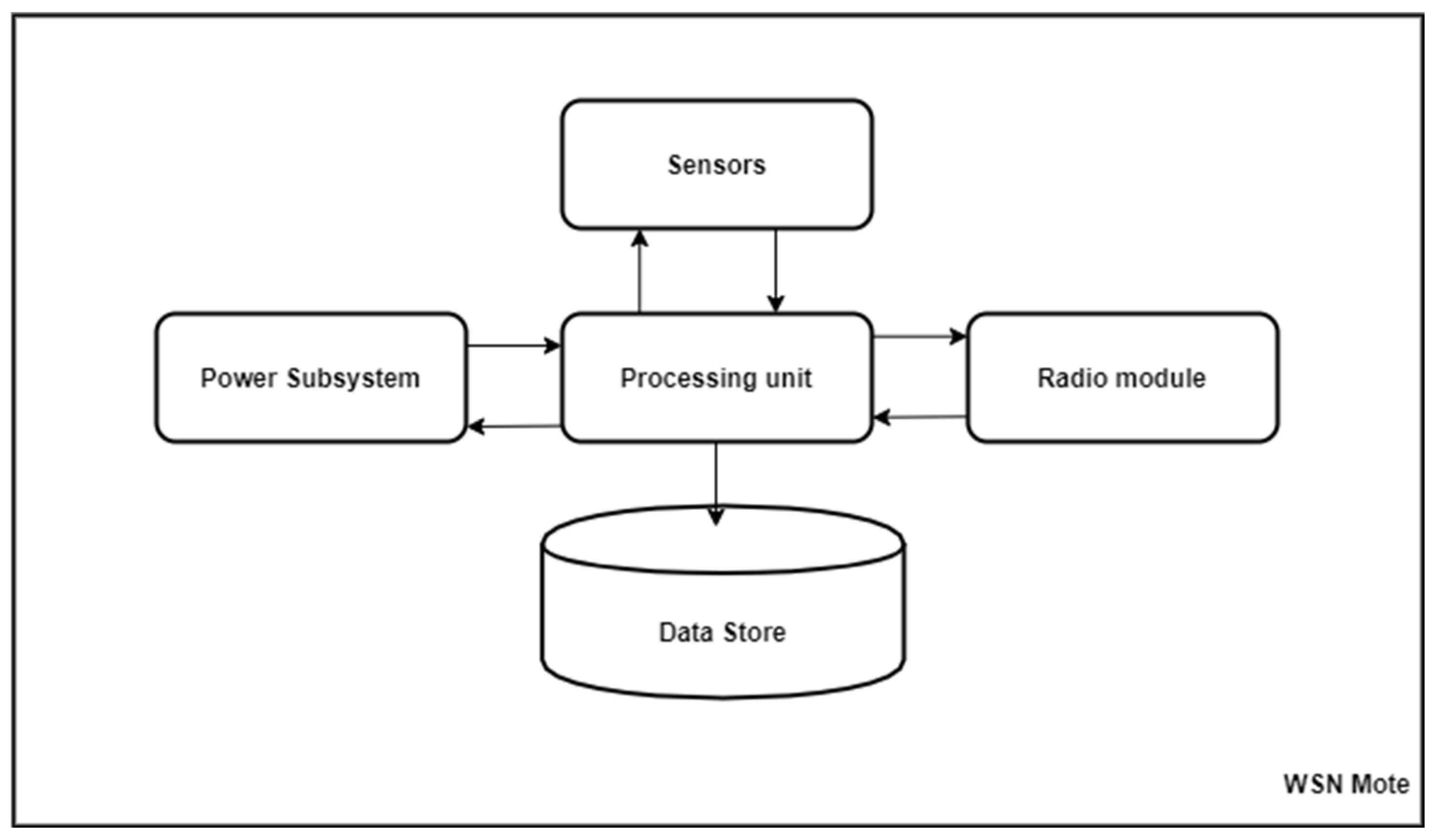
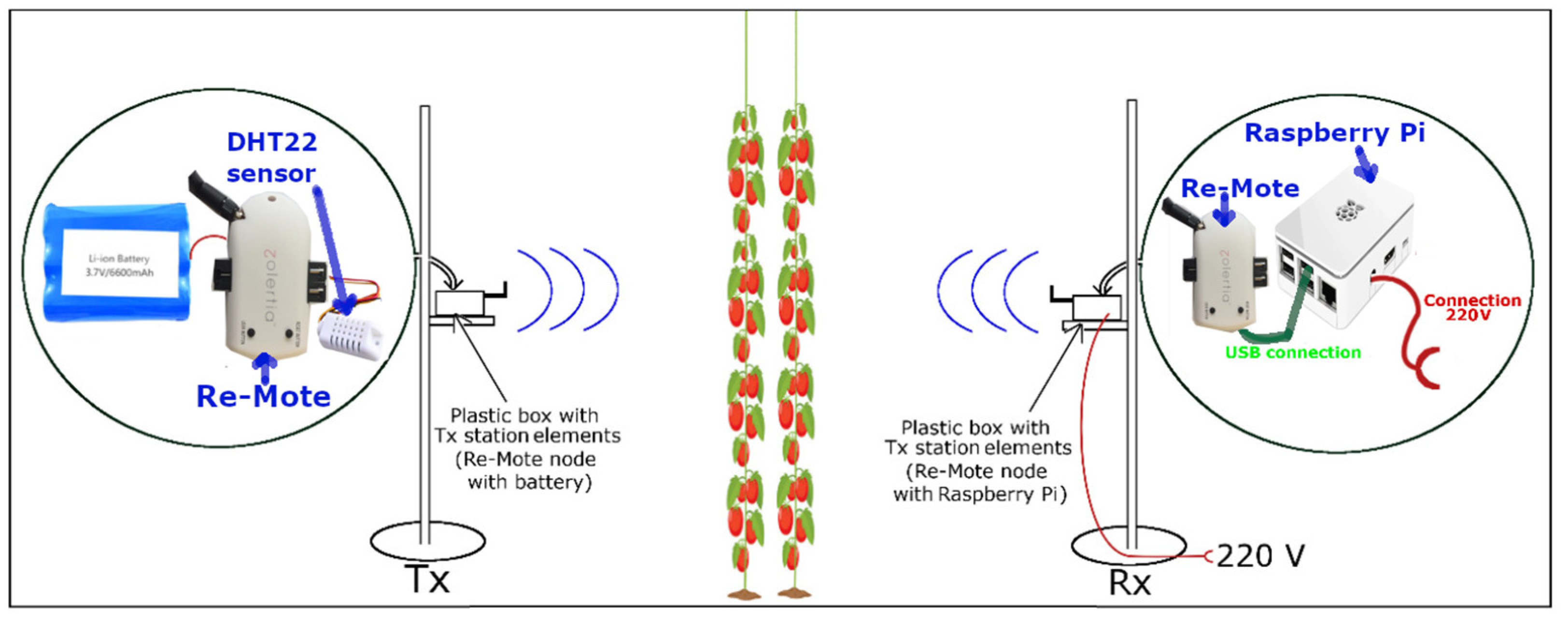
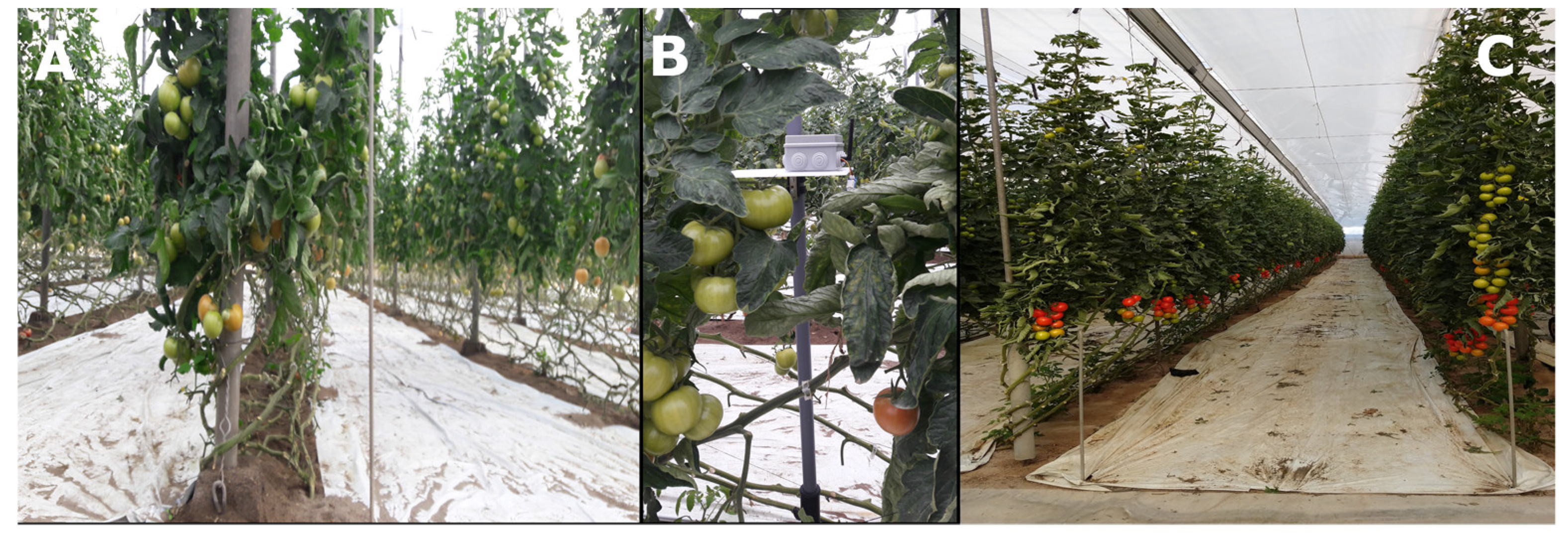

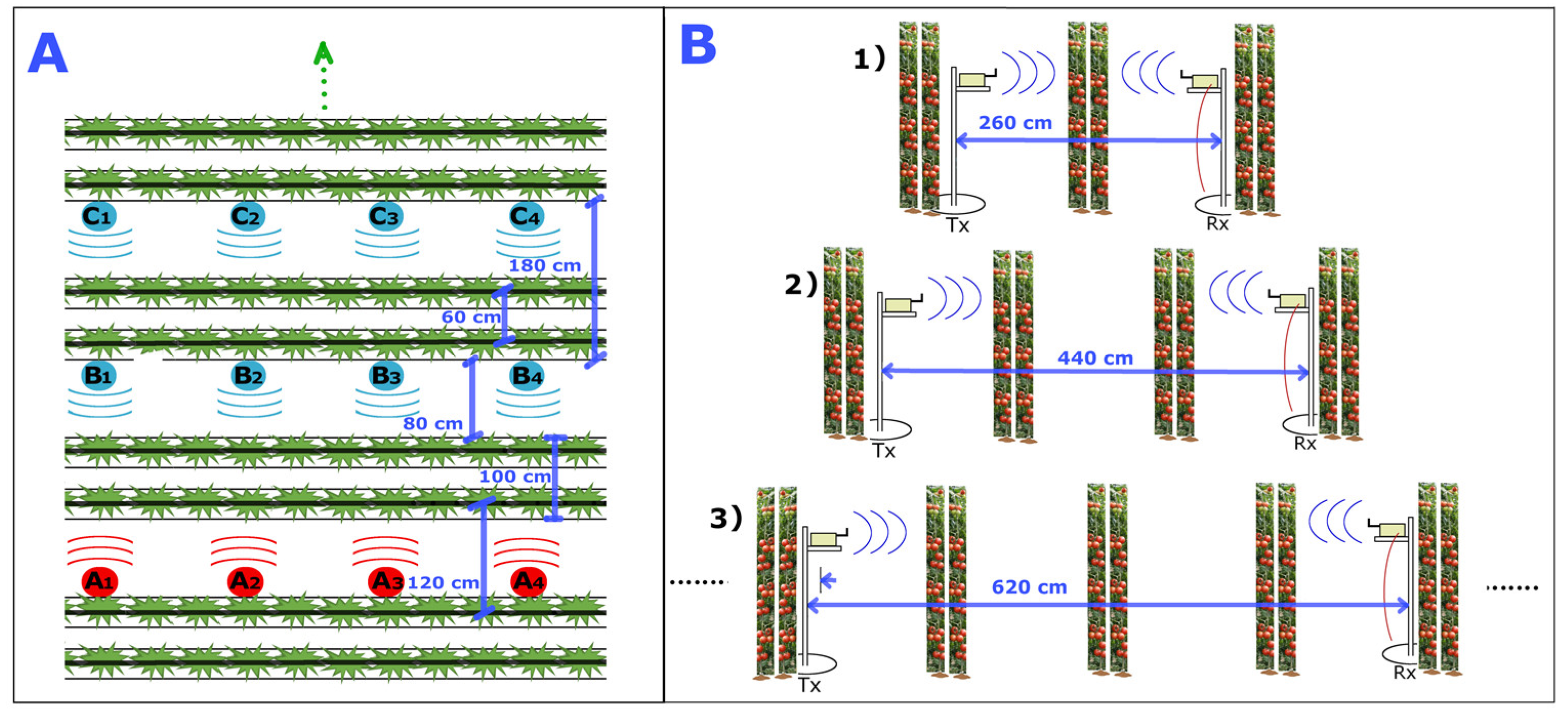
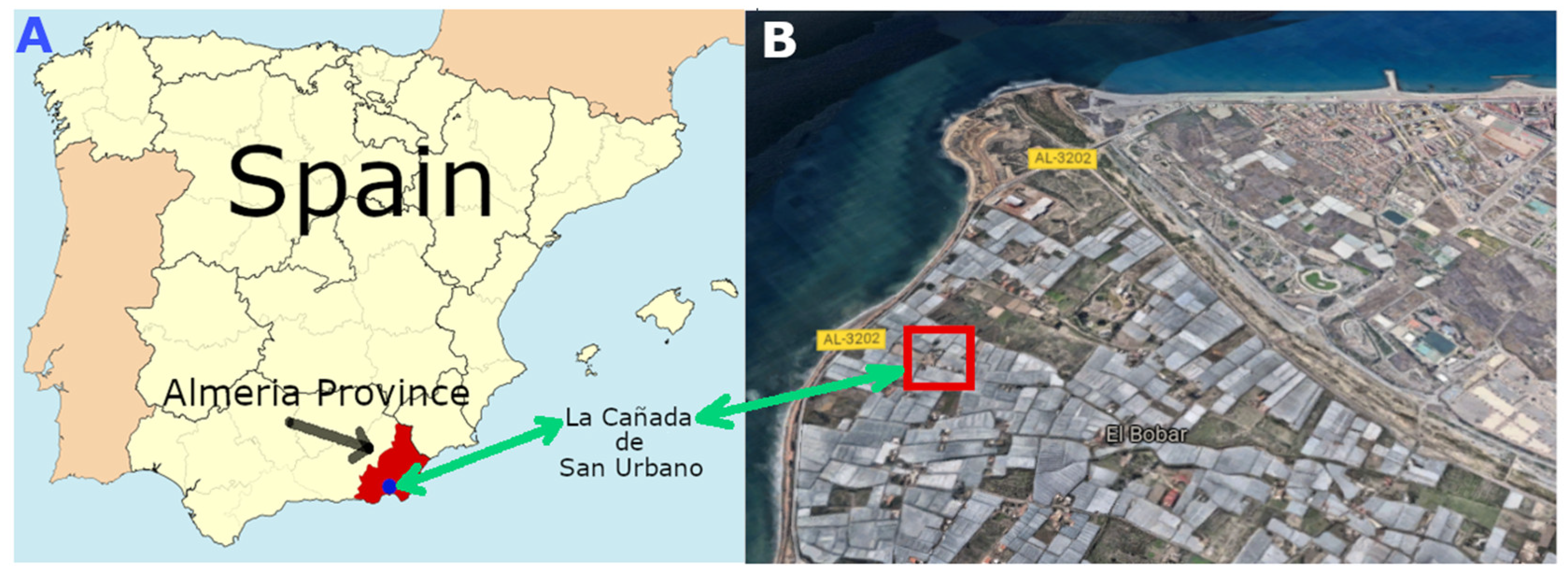
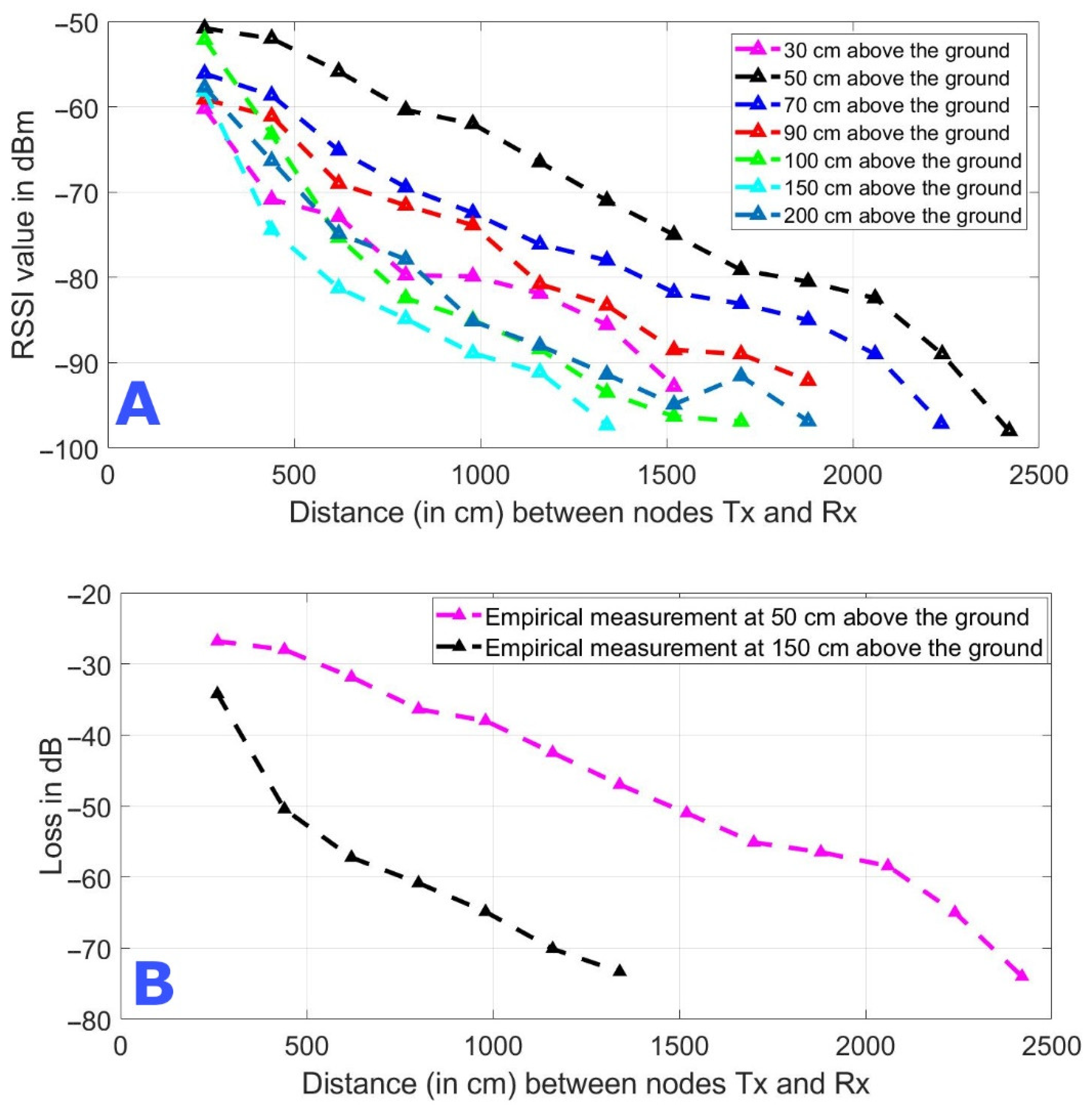
| Cycle | Temperature | Humidity | RSSI | Date | Hour |
|---|---|---|---|---|---|
| 1 | 14 | 63 | −93 | 25 March 2018 | 11:37:48 |
| 2 | 14 | 63 | −93 | 25 March 2018 | 11:37:58 |
| 3 | 14 | 63 | −93 | 25 March 2018 | 11:38:08 |
| 4 | 14 | 63 | −93 | 25 March 2018 | 11:38:18 |
| 5 | 14 | 63 | −93 | 25 March 2018 | 11:38:28 |
| 6 | 14 | 63 | −94 | 25 March 2018 | 11:38:38 |
| 7 | 14 | 63 | −94 | 25 March 2018 | 11:38:48 |
| 8 | 14 | 63 | −94 | 25 March 2018 | 11:38:58 |
| 9 | 14 | 63 | −94 | 25 March 2018 | 11:39:08 |
| 10 | 14 | 63 | −93 | 25 March 2018 | 11:39:18 |
| 11 | 14 | 63 | −93 | 25 March 2018 | 11:39:28 |
| 12 | 14 | 63 | −93 | 25 March 2018 | 11:39:38 |
| 13 | 14 | 63 | −93 | 25 March 2018 | 11:39:48 |
| 14 | 14 | 63 | −92 | 25 March 2018 | 11:39:58 |
| 15 | 14 | 63 | −91 | 25 March 2018 | 11:40:08 |
| 16 | 14 | 63 | −91 | 25 March 2018 | 11:40:18 |
| 17 | 14 | 63 | −91 | 25 March 2018 | 11:40:28 |
| 18 | 14 | 63 | −91 | 25 March 2018 | 11:40:38 |
| 19 | 14 | 63 | −91 | 25 March 2018 | 11:40:48 |
| 20 | 14 | 63 | −91 | 25 March 2018 | 11:40:58 |
| 21 | 14 | 63 | −91 | 25 March 2018 | 11:41:08 |
| 22 | 14 | 63 | −91 | 25 March 2018 | 11:41:18 |
| 23 | 14 | 63 | −91 | 25 March 2018 | 11:41:28 |
| 24 | 14 | 63 | −91 | 25 March 2018 | 11:41:38 |
| 25 | 14 | 63 | −91 | 25 March 2018 | 11:41:48 |
Publisher’s Note: MDPI stays neutral with regard to jurisdictional claims in published maps and institutional affiliations. |
© 2021 by the authors. Licensee MDPI, Basel, Switzerland. This article is an open access article distributed under the terms and conditions of the Creative Commons Attribution (CC BY) license (https://creativecommons.org/licenses/by/4.0/).
Share and Cite
Cama-Pinto, D.; Holgado-Terriza, J.A.; Damas-Hermoso, M.; Gómez-Mula, F.; Cama-Pinto, A. Radio Wave Attenuation Measurement System Based on RSSI for Precision Agriculture: Application to Tomato Greenhouses. Inventions 2021, 6, 66. https://doi.org/10.3390/inventions6040066
Cama-Pinto D, Holgado-Terriza JA, Damas-Hermoso M, Gómez-Mula F, Cama-Pinto A. Radio Wave Attenuation Measurement System Based on RSSI for Precision Agriculture: Application to Tomato Greenhouses. Inventions. 2021; 6(4):66. https://doi.org/10.3390/inventions6040066
Chicago/Turabian StyleCama-Pinto, Dora, Juan Antonio Holgado-Terriza, Miguel Damas-Hermoso, Francisco Gómez-Mula, and Alejandro Cama-Pinto. 2021. "Radio Wave Attenuation Measurement System Based on RSSI for Precision Agriculture: Application to Tomato Greenhouses" Inventions 6, no. 4: 66. https://doi.org/10.3390/inventions6040066
APA StyleCama-Pinto, D., Holgado-Terriza, J. A., Damas-Hermoso, M., Gómez-Mula, F., & Cama-Pinto, A. (2021). Radio Wave Attenuation Measurement System Based on RSSI for Precision Agriculture: Application to Tomato Greenhouses. Inventions, 6(4), 66. https://doi.org/10.3390/inventions6040066








